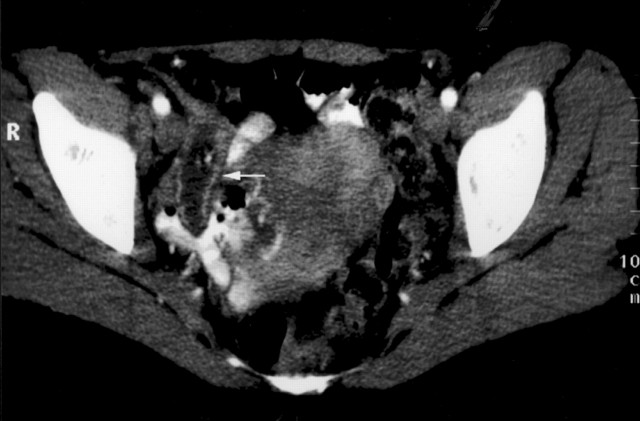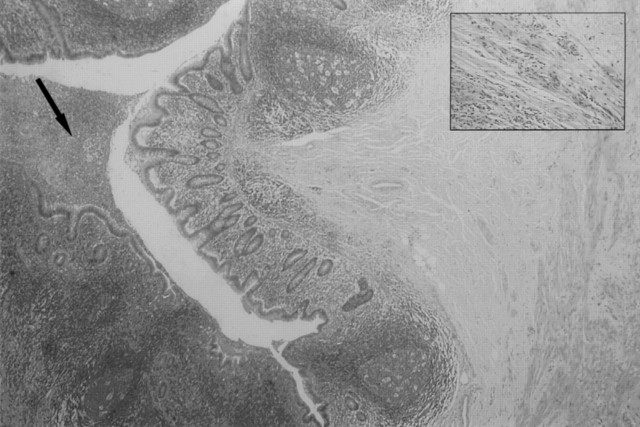Appendicitis after appendicectomy usually results from inflammation of an incompletely removed proximal portion of the appendix—stump appendicitis. We present a less common, distal, variant.
CASE HISTORY
A woman aged 34 was initially seen after two days of central abdominal pain radiating to the right iliac fossa. She was pyrexial with a leukocytosis and the clinical findings supported a diagnosis of acute appendicitis. Appendicectomy was performed conventionally without burial of the appendix stump. The operation was described as difficult and a ‘ruptured’ appendix was removed with insertion of a drain. Appendicitis was confirmed histologically in the fragments presented. The patient made a slow but uneventful recovery and was discharged after ten days.
Two months after discharge she returned with abdominal discomfort beneath the wound scar, which appeared well healed. The drain site was discharging clear fluid. The abdominal discomfort did not settle and a CT scan was requested, to rule out an underlying intraabdominal abscess. This showed the appendix stump to be healthy but revealed an inflamed fluid-filled cavity beneath the wound suggestive of a walled-off abscess (Figure 1). At diagnostic laparoscopy the cavity proved to be a 3 cm distal remnant of the appendix with the appendicular artery and mesoappendix still attached. A large appendiceal remnant was then removed from the lateral wall of the pelvis. The histological appearance was consistent with persistent appendicitis (Figure 2).
Figure 1.
CT scan showing fluid-filled mass in right pelvis
Figure 2.
Histology of retained appendix specimen. Appendix lumen is distended with pus (arrow). An acute and chronic inflammatory cell infiltrate is present throughout the layers of the appendix wall (see insert for higher magnification)
COMMENT
About 10 000 appendicectomies are performed each year in England and Wales1 with case fatality of 0.2%.2 The commonest causes of postoperative morbidity are wound infections, intra-abdominal abscess, adhesions, and bleeding. Appendicitis of an appendiceal remnant is a rare complication that can be hard to diagnose. Stump appendicitis (incidence 1 in 50 000 cases)3 can develop at any time after the initial operation. Usually this is within the first year but in one reported case the interval was 21 years.4 We have not found a previous report of appendicitis affecting the distal remnant.
The diagnosis of post-appendicectomy appendicitis should be considered, first, in patients with persistent symptoms or sepsis after appendicectomy and, secondly, in patients with signs and symptoms of appendicitis but with a history of appendicectomy. CT and laparoscopy are the most useful diagnostic investigations. The cause is incomplete removal, and in difficult cases such as that reported here, surgeons must take particular care to ensure that nothing of the appendix remains.
References
- 1.Baigrie RJ, Dehn TCB, Fowler SM, Dunn DC. Analysis of 8651 appendicectomies in England and Wales during 1992. Br J Surg 1995;82: 933. [DOI] [PubMed] [Google Scholar]
- 2.Bisset AF Appendicectomy in Scotland: a 20 year epidemiological comparison. J Publ Health Med 1997;19: 213–18 [DOI] [PubMed] [Google Scholar]
- 3.Mangi AA, Berger DL. Stump appendicitis. Am Surg 2000;66: 739–41 [PubMed] [Google Scholar]
- 4.Thomas SE, Denning DA, Cummings MH. Delayed pathology of the appendiceal stump: a case report of stump appendicitis and review. Am Surg 1994;60: 842. [PubMed] [Google Scholar]




